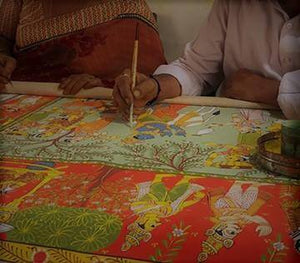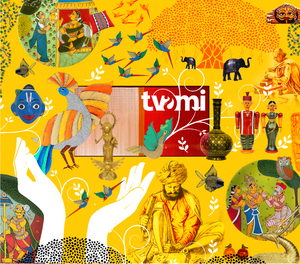
Sholapur Wall Hangings
Sholapur city is in the south-western region of Maharashtra and is 410 km away from Mumbai. Sholapur is the fifth largest agglomeration of Maharashtra. The hard work of people living here has transformed Sholapur from being merely a small town to a full-fledged commercial and tourist hub. Sholapur today is an active hub of traditional art and diverse culture and is especially known for its best-known creation- Sholapur Wall Hangings. Sholapur Wall hangings are a form of textile art, being in style from very long ago. Apart from being a fancy piece of art, wall hangings have narrated history and are an essential part of art and culture.
Origin
Wall hangings have always been an essential part of our home-decor since 300 BC. India is one of the vibrant centre’s for wall hangings. Tapestries have been used since the Hellenistic times. The handloom weaving is known to be commenced in the regime of the Peshwas.
With the migration of Padmashalis in Sholapur, the handloom industry prospered. The craftsmanship and diverse cultures of Sholapur have resulted in the best artwork.
Technique
The yarns used for wrap and weft are first collected from the Sholapur itself. The Hanks are then cleaned, wetted and bleached. After bleaching, the hanks are dyed with beautiful colors obtained from vegetable dyes and, are lastly weaved with wooden rods as support, according to the required patterns and designs. To make these more decorative, the wall hangings are adorned with bells, beads and mirrors.
What makes it special?
The wall hangings are a result of sheer hard work and patience of the artisans. Made from warp and weft technique, they are ornamented in nature and involve cutwork, which makes them stand out from the rest of the handloom hangings. The wall hangings were initially started with the designs of deities, but later, artisans gave a contemporary touch to this traditional art form.
The future
Established nearly 50 years ago, this handloom art-form is a not so old yet, culturally important. With time, significant changes have been observed in weaving methods and raw materials. The cotton threads are now replaced with wool wand silk threads due to their low cost and easy accessibility. The vegetable dyes are replaced with chemical colors.
The artisans have faced losses during the past few years due to the decline in the demands. Artisans, being not much interested in practicing this craft, are now looking for alternate options for their emoluments. The succeeding generations also do not seem to be much interested in handloom weaving, impacting the overall business of this craft.



Leave a comment